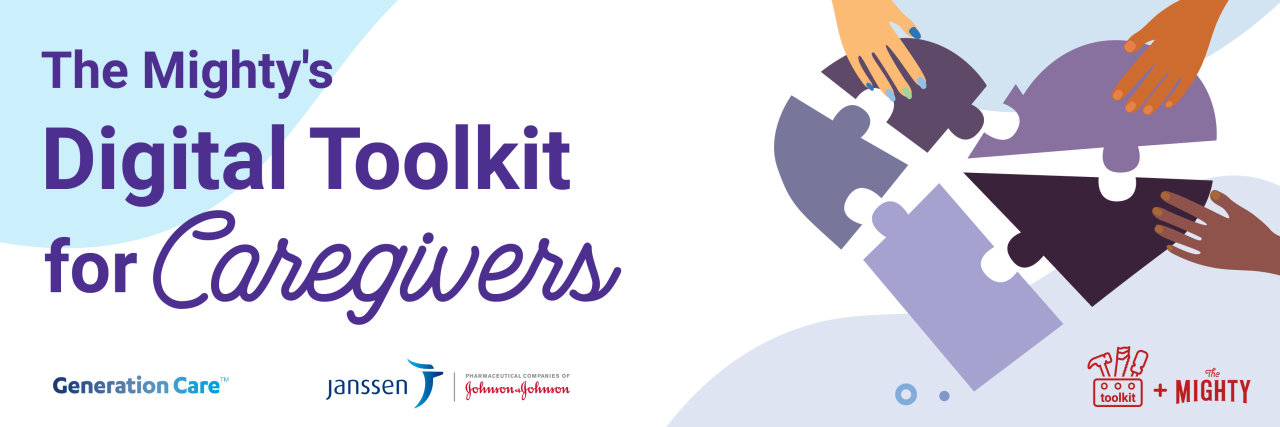Digital Toolkit and Tips for Caregivers
The Mighty’s educational content aims to support you and your loved ones through your health journeys. For this caregiver toolkit, The Mighty talked with long-term caregivers, patients and health professionals to compile a list of tips for caregivers that help avoid caregiver burnout, caregiver stress, and a range of other issues. We also surveyed more than 150 caregivers to learn more about their experience and the caregiver burden. Please consult your doctor or other qualified healthcare provider with any questions you may have regarding a medication or treatment.
Caregiving can be a rewarding experience, but it can also be stressful and challenging at times — and that’s OK! That’s why we’ve created this toolkit, so you can learn more about the ins and outs of caregiving and discover helpful resources you can utilize along your caregiving journey. Take what you need, and share it with others too.
Here’s what’s included in The Mighty’s Digital Toolkit for Caregivers:
- A caregiving binder, complete with worksheets to help you better organize important information for the person you care for such as allergies, medical history, provider information and more.
- A respite care questionnaire that helps you find the perfect respite worker for your specific needs, plus resources for respite workers to use while you’re away.
- A self-care mini guide to help you destress and prioritize your mental health.
P.S. Everything included in this toolkit is downloadable, printable and shareable!

The content below is supported by the answers of over 150 caregivers we surveyed as well as caregiving professionals. Karin Willison, Mighty senior editor and blogger at Free Wheelin’ Travel, and Lexi Silva, Mighty Leader and caregiver advocate.
What Does It Mean To Be a Caregiver? | Types of Caregivers | Caregiving Binder | How To Find a Caregiver or Respite Help | How To Support Caregivers | Caregiving and Mental Health |

What Does It Mean To Be a Caregiver?
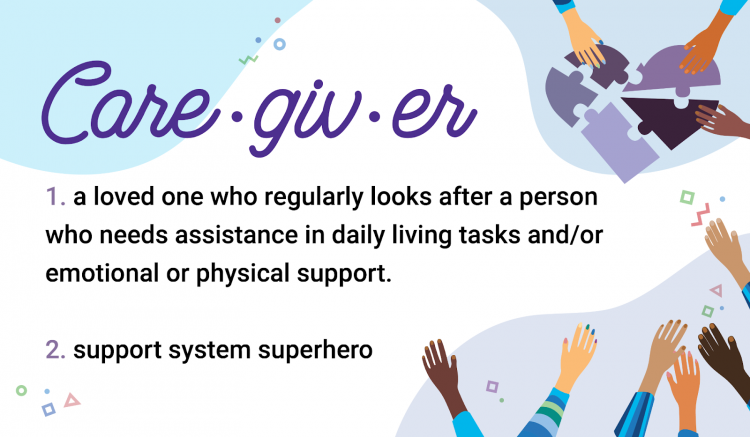
Caregiving means something different to every person who steps into the role. Perhaps you’re a husband, wife or partner taking care of your significant other. Maybe you’re the parent of a child with a health condition or disability. Or you may not be related to the person you’re giving care to at all, and are a longtime friend. No matter what your relationship is to the person you help, the caregiver is a critical part of an individual’s support system.
To better understand what caregiving means to caregivers, we asked our Mighty community about their experience and about the top advice and tips for caregivers they might have to offer. Here is what they had to say:
“Caregiving enables our loved ones to have the best possible quality of life, for the rest of their life. It is a great responsibility, but also a great honor to be able to change one’s life in that way.”
“Everyone has the right to live their lives with dignity, independence and happiness. To me, being a caregiver allows you to be a conduit for a person to have those three things. You can advocate for their rights, assist them so that they can live as independently as possible and help facilitate opportunities for them to pursue their passions or simply things that bring them joy.”
“Being a caregiver means providing the support my parent needs. I help her by taking her to appointments, refilling her medications, paying her bills, and occasionally cooking for her. I also provide social support being the only person she really spends time with.”
“Love and sacrifice.”
“I took care of my father with the help of hospice. I have multiple chronic illnesses myself. Many days we were over extended and wiped out. Yet, I made it through thinking about how I too hope to be home and comfortable when it’s near the end. I was blessed to be able to spend this time with my dad.”
Types of Caregivers
When people think of caregiving, an image of a home health worker who assists someone with bathing, exercising or eating may come to mind. While medically trained caregivers do play a critical role, caregiving comes in many forms. If you are a person who assists with daily living activities, or supports the emotional or physical well-being of another person, you are a caregiver.
Some examples include:
- A parent or guardian managing their child’s medications and school supports
- A grandchild shopping and preparing food for their grandparents who can no longer do it alone
- Someone providing emotional support
- A child ensuring the safety of a parent with Alzheimer’s
- A friend who drives another to cancer treatments and helps out their family
- An individual who researches resources and supports someone through their mental health journey
The level of support and responsibility a caregiver provides for another person also varies. For example, an elderly couple where a husband has multiple sclerosis may live with his wife, the primary caregiver. She is the person who provides care to the best of her physical and emotional ability. A secondary caregiver could be a child or family member who can support them in areas of need, such as managing doctor’s appointments, transportation and housework. They may also assist the primary caregiver with errands or help give the primary caregiver time to herself. This is called respite care. A tertiary caregiver may be a home-health physical therapist, occupational therapist or companion to provide socialization. One of the most important self-care tips for caregivers is to seek assistance from others who could potentially act as respite care providers, helping avoid caregiver fatigue and other challenges.
Whether you identify with any of the descriptions listed above or have taken on a different role, your efforts matter. Caregiving doesn’t have a look. It’s so much more than a stereotype.

Caregiver Binder
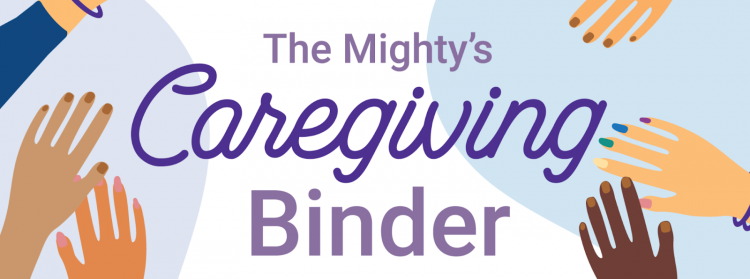
Caregiving requires a lot of organization. In fact, finding ways to track symptoms is one of the most important tips for caregivers you could follow. We know that navigating medical records across different hospital systems can be challenging, especially when there is more than one home care provider in the mix. That’s why we created this printable caregiving binder, so you can consolidate the important information you need to keep track of medical records, relevant contact information and important documents — all in one place. Plus, you can print copies and share them with family members, respite workers and new providers as needed.
Medication List
With this worksheet, you can write out all of the medications your loved one uses and keep important notes, like the frequency of a specific medication, who the prescribing physician is and any special considerations to remember when giving the medication. When it comes to useful tips for caregivers of elderly, keeping close watch of medication schedules using a worksheet is probably the best advice if you want to make the process easy to manage.
Medical Team
Medical teams come in all sizes and combinations, but as they grow it can be challenging to remember which role each member plays as well as the relevant contact information. Our medical team worksheet helps you keep track of appointments, phone numbers and the names of everyone on your loved one’s health care team.
Allergy List
Keeping track of allergies — dietary, seasonal, medical or otherwise — is an important part of caregiving. With this sheet, you’ll be able to write down all the important details, including the person’s reaction. Plus, you can print out copies to give to others so that they’ll be in the know as well.
Procedure History
When sharing someone’s medical records with a new provider, they’ll want to know your loved one’s procedure history. That’s why we created this worksheet to help you keep track of relevant procedures (both inpatient and outpatient), which physician ordered them and when they were performed.
In Case of a Crisis
Even though we try to avoid crisis and emergency situations as much as we can, they do happen sometimes. This worksheet will help you prepare just in case. You can fill it out in advance and make several copies to share with ambulance workers, ER physicians and hospital staff. Should a crisis arise, we hope this worksheet can help make it a little bit less stressful.
Additional Documents
We hope the toolkit items we outlined above will help you start a caregiving binder that’s unique to your situation. Some other documents you may want to consider adding to the binder include legal documents like an advance directive or do-not-resuscitate (DNR) order. You can check off which documents you’ve chosen to include.
Here are some additional caregiving resources to check out:

How To Find a Caregiver or Respite Help
A respite caregiver can be an important part of your caregiving support network. The goal of respite care is to provide short-term relief for you, the primary caregiver, from your typical caregiving duties. Generally, a respite caregiver will take over caregiving responsibilities for a set number of hours. They can be available for a particular afternoon or for a few days or weeks. Respite care can be provided at home or in an outside facility such as an adult day care or hospital. This provides an opportunity for the caregiver to rest, and can also serve as a way to help relieve their stress, as well as protect their mental health and well-being. As a caregiver, you can relax and recharge during your time away knowing your loved one is in a safe environment and being cared for by professionals.
Another form of respite care are short- and long-term home health aides that your loved one may be eligible for, depending on their level of independence. These aides usually assist in daily living activities such as bathing, eating and some light cleaning for a set number of hours per week. When the aides are in the home, the primary caregiver is able to rest and leave the house.
If you read the previous paragraphs and your first thought was that respite care is just the thing you need, your second thought may turn to worry: How would you pay for it? Unfortunately, paying for respite care can be complicated. If your loved one is eligible for home health, Medicare or Medicaid will cover the cost of care for a certain number of hours per week, as determined by your loved one’s doctor and/or state Medicaid evaluators. If your loved one is not eligible for home health care, payment can be more difficult, as most insurance plans do not cover the cost for this type of respite care. However, Medicare may cover the cost of up to five days in a row of respite care in either a hospital or a skilled nursing facility, depending on the needs of the patient. If your loved one is in hospice, then respite care may be covered.
In order to help you organize and evaluate potential respite care, The Mighty has developed a checklist you can use to determine if a particular respite caregiver is a good fit for your situation. It’s important to feel comfortable with your respite caregiver so you can relax and recharge during your break from caregiving duties. We hope this checklist gives you some peace of mind!
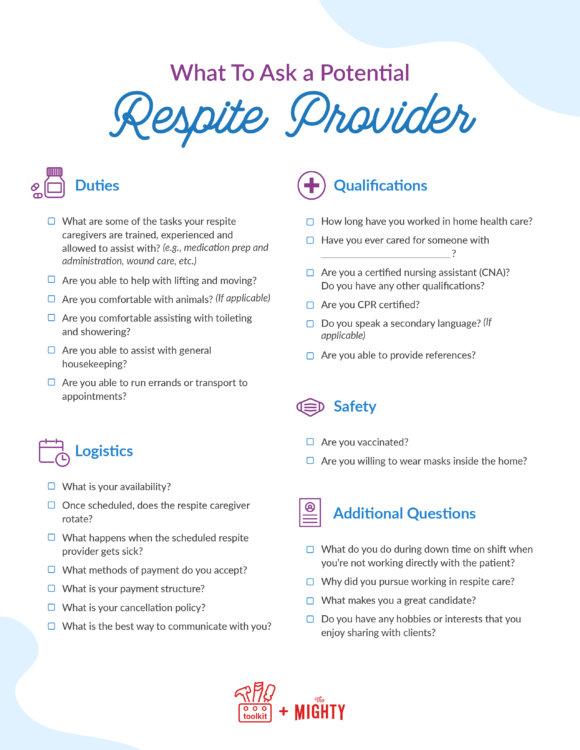
Once you’ve chosen your respite caregiver, it’s important to help them understand the specific needs and typical routine of your loved one. You should also feel empowered to ask for feedback and/or progress updates on the respite caregiver’s time with your loved one. That’s why The Mighty created a list of daily activities you can personalize as well as a worksheet. These printable tools can help you communicate more easily with your respite caregiver about what your loved one does on a daily basis, the level of assistance they require with performing these activities, as well as what happened during the time they spent together.
To learn more about finding respite care, check out these resources:
- Disability Home Care Guide
- Hospice Services
- Medicaid Service and Support
- Medicare and Respite Care Coverage
- Private and Additional Care Options:

How To Support Caregivers
While caregiving can be incredibly rewarding, it also can be challenging. Caregivers focus a lot of their time and energy on their loved ones and have the tendency to push some of their own needs aside. In a survey we conducted of 150 caregivers, 52% of the respondents also identified as living with a health condition themselves. Balancing the care of a loved one while also managing a personal health condition can be difficult. But even if you don’t live with a health condition yourself, we know that caregiving can impact your mental health and stress levels, finances, relationships and career plans. In fact, many suffer from caregiver burnout symptoms, with some even dealing with caregiver depression. That’s why we’ve created this section of the toolkit just for you, with tips, insights and resources from other caregivers to help you along the way.
No matter the type of caregiver you are, know that you’re not alone in this journey. It’s OK to feel frustrated and exhausted, and it’s understandable if you need to take a break sometimes — we’re all human. Just because you need some space away from the person you’re caregiving for doesn’t mean you love them less.
We asked caregivers about some of the struggles they face in caregiving. Here’s what they had to say:
- “Being a caregiver is exhausting physically, mentally and emotionally. It can completely change the dynamics of your relationship with the loved one you’re caring for — as well as every other relationship in your life.”
- “Caregivers need a break sometimes to care for themselves, and we can’t always rely on other family members for that.”
- “How isolating it can be. How impossible it is to struggle with my own chronic condition while managing my son’s and my mother’s health, too. More compassion. More help. I’m hanging on by a thin thread. And I’m hungry. I wish I had the time and energy to cook healthy meals every day. And I can’t put gas in my car.”
- “I finally accepted that taking time for myself isn’t selfish. It’s necessary.”
- “It is vital that the caregiver have their own life away from the person they care for so that their world is not only just caring for the loved one. It will leave you with nothing.”
You’re not alone in this — our Mighty community is here for you. The following sections include resources for some of the challenges the caregivers we surveyed face. Maybe they’ll help you too. Whether you’re looking for tips for caregivers of dementia patients or are interested in learning how other families are dealing with various caregiver challenges, our active online community can be very helpful.
Pursuing School or a Career
Balancing the responsibilities and time devoted to caregiving alongside your education or career can be difficult to navigate. It is estimated that 53 million in the United States are caregivers for loved ones and 60% of those people balance earning a paycheck with their caregiving duties — that’s nearly 32 million Americans who have jobs in addition to serving as a caregiver for a loved one!1
Many caregivers are also pursuing an education: 1 in 10 is enrolled in college or other classes. Many of these student caregivers also work, on average, 32 hours a week. Seven in 10 of these student caregivers also say caregiving has impacted their academic performance.2
So how can employees and students who are caregivers find the support they need to help manage their stress alongside the duties of work, school and caregiving? Employees should familiarize themselves with the benefits their company may provide as well as any rights they may have through the Family and Medical Leave Act (FMLA). Your company may provide things like options to work flexible hours, support through counseling and the ability to use paid time off to care for your loved one. If you are covered by FMLA, you should be entitled to take up to 12 weeks off of unpaid leave a year to care for a spouse, child or parent. A good person to talk to about any benefits you may have or your rights under FMLA is your company’s human resources representative.
For student caregivers, the process of receiving support from their school is often less clear. Only 1 in 5 students reported that their schools had no policies in place to support caregivers of adult loved ones.3 It was also less apparent which school official students should turn to for support. Student caregivers reported turning to instructors, academic advisors and residential assistants, among others, when they felt they needed support.
Some resources you can utilize to help balance caregiving and school and discover tips for caregivers receiving an education include:
- American Association of Caregiving Youth
- Caring Senior Service
- Student Caregiver Scholarship Opportunities
Managing Finances
Many caregivers assist their loved ones with financial decisions. This type of financial caregiving can involve responsibilities ranging from budgeting for groceries, to helping pay bills, to assuming full control over someone else’s finances with a legal document called a “power of attorney.” If you’ve noticed that a loved one is having trouble managing their money due to memory issues or other health problems, or you are just planning for the future, the Consumer Financial Protection Bureau (CFPB) has created a useful guide to help you decide what type of assistance your loved one needs.
The CFPB’s guide will help you decide which type of financial caregiver you are: formal or informal. If you are someone your loved one brings along to appointments at the bank or even adds to a checking account, you are considered an informal caregiver. Formal caregiving involves legal documents and designations like “power of attorney” or “guardian” that give you total or much more control over someone else’s finances. The guide also contains a list of questions to help determine if you are a good fit for being a financial caretaker. There are also more resources to help explain what the legal terms for formal caretakers mean, for example, “trustee” and “guardian.”
In addition to assisting with the management of your loved one’s finances, caregiving may also have an impact on your own personal finances. In our caregiver survey, almost 70% of caregivers have a difficult time meeting their essential household expenses. Caregiving can become a full-time responsibility, and juggling two jobs — one at home and one in the office — can be very difficult. Our survey showed that of those who quit their jobs, 67% of them were parents and 55% of them were taking care of loved ones with or experiencing a mental health condition themselves.
If you’re struggling to keep up with your finances, the finances of your loved one or both, you’re not alone. Here are some resources you can use to help explore your options:
- ABLE Savings Account
- An Introduction to Long Term Care Insurance
- An Introduction to Personal Care Agreements
Balancing Caregiving Relationships
Caregiving can impact relationships you have, both with the person you’re caring for and your relationships with others. Most caregivers don’t report conflict with their family members due to their caregiving relationship. However, relationships with other members of your family can become strained due to disagreements over things like how to best manage finances, which courses of treatment should be pursued for your family member’s illness and how the responsibilities of caregiving should be divided among family members. In a study, over 20% of caregivers reported some level of disagreement with their family members about their loved one’s care.
In addition to issues that can arise directly from not seeing eye-to-eye with your family members about your loved one’s care, caregiving can also impact your relationship with your partner. For example, adults who were longer-term caregivers said they weren’t as happy in their marriages as those who had recently started caregiving. This suggests that the strain of caregiving responsibilities builds over time. It’s so important for caregivers to carve out space for themselves and their partners by utilizing things like respite care so they can avoid burnout and lessen the potential negative impacts on their other relationships. Spending time focused on your partner can remind them that you value them and your relationship even though you may have to devote a lot of time and energy to your caregiving duties.
Some ideas you can try to focus on your relationships outside the caregiving role can include:
- Game nights with the family
- Food delivery and having a date night at home
- Streaming a new movie you’re both eager to see
- Playing music together or listening to your favorite songs
- Going to visit a local museum or park
- Having a “slumber party” with your child at home
- Subscribing to a monthly specialty box delivery service where you can receive an assortment of items from crafting projects to snacks
Caregiving can also take time away from other relationships outside of the family. It’s important to keep in touch with your friends, and doing so can help support your mental health. You may sometimes feel guilty for leaving your loved one at home or with a respite worker, but know that taking the time for yourself will ultimately strengthen your caregiving relationship because you won’t be as burnt out. If you’re struggling to manage the caregiver relationship, consider family counseling. A counselor may also help you identify signs of burnout in yourself and provide you with additional support and tools to manage the stress involved in caregiving, and how best to navigate balancing relationships as a caregiver.
Caregiving and Mental Health
The circumstances that caregivers face every day can be stressful. In our survey, 61% of caregivers felt they need more stress relief to help cope with caregiving. These increased levels of stress can affect both your physical and mental well-being. Much like the person you are caring for, caregivers need support for their own health too. Without breaks or relief from the duties and responsibilities of caregiving, life can feel overwhelming and caregivers may develop burnout as a result. This stress and burnout is at least partially responsible for caregivers’ elevated risk of developing a mental health condition. Our survey also showed that 84% of respondents felt that the impact on their mental health had been the most challenging component of caregiving.
The American Psychological Association recommends that all caregivers, at a minimum, undergo a mental health screening provided by a health care professional at some point in the caregiving process. In addition to caring for yourself by making the time to seek appropriate care from professionals, self-care can and should be part of your overall mental health care plan. When caregivers make time for themselves, they help to ensure they are physically and mentally healthy enough to continue looking after their loved ones. In order to encourage self-care, The Mighty has included a few gentle reminders in this toolkit. Your needs matter.
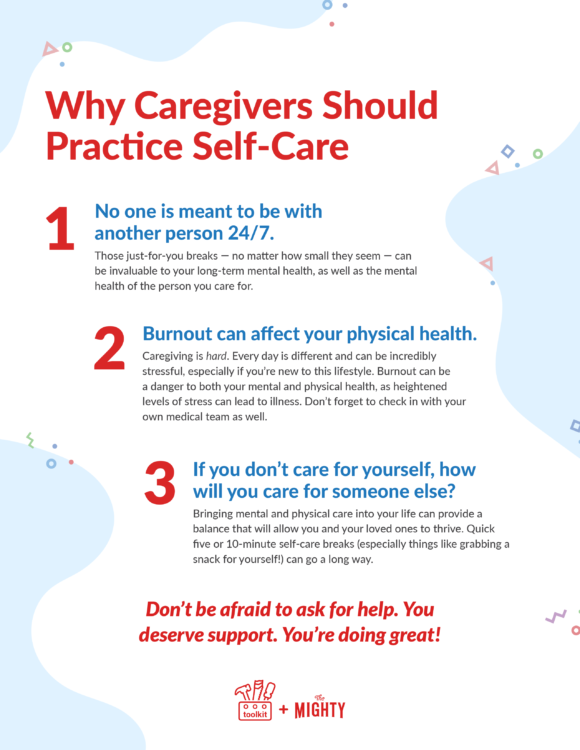
We also talked to caregivers about what they do to help protect their mental health. Here’s what they said:
- “I recharge at night — after a long day at work followed by hours of caregiving, I like to snuggle up in my bed and read a good book. Maybe I go to bed too late from it more nights than not, but the quiet recharges me more than anything else.”
- “Hiking is my go-to destressor. I talk with my best friend on the phone and just get out into nature a little bit. Having a beautiful view at the end doesn’t hurt either.”
- “Kayaking is my favorite way to destress. I also enjoy curling up on the couch with a good book. Sometimes I get carried away and read for hours, but I think it is important to take that time for myself.”
- “Having a nice shopping trip where you buy what you like. Pamper days with a bubble bath, listening to your favorite music and spending time with loved ones. Watching a movie, garden or bake — hobbies you enjoy. I love creating handmade cards and gifts.”
- “By taking each day as it comes, one step at a time, one day at a time. Listen to music, read books, and don’t worry about those things I cannot control.”
- “Try to go get a massage once a month, have planned phone calls with other moms in similar medical situations. Hand the kids/caretaking over to my husband at least twice a month to go run errands or something alone. Write through my feelings.”
- “I find hobbies and activities I can do both with my parent and in my own free time. I crochet, read and spend time with my friends.”
You can also check out these stress-management tools and resources:
- American Psychological Association
- Anxiety & Depression Association of America
- Insight Timer
- NPR Isle of Calm: 6 Hours of Calming Music
- UCLA Guided Meditation Podcast
How to Get Help In a Crisis
If you’re struggling with suicidal thoughts, know you are not alone. There is help for people who feel suicidal. If you need help right now, you can call the National Suicide Prevention Lifeline at 1-800-273-8255 or text “START” to 741-741. Head here for a list of crisis centers around the world and visit our suicide prevention resources.
Neither The Mighty nor Janssen are responsible for the content or Privacy Policy of any third-party websites. This toolkit was created with funding provided by Janssen Global Services, LLC.
© Janssen Global Services, LLC, 2021. All Rights Reserved.

1AARP, N. A. for C. (2020, May 14). Caregiving in the United States 2020. AARP. Retrieved September 19, 2021, from https://www.aarp.org/ppi/info-2020/caregiving-in-the-united-states.html.
2Hartman O’connell, I., & Skufca, L. (2020, September 1). The unique experience of students who are family caregivers. AARP. Retrieved September 5, 2021, from https://www.aarp.org/research/topics/care/info-2020/student-caregiver-survey.html.
3Ibid.


